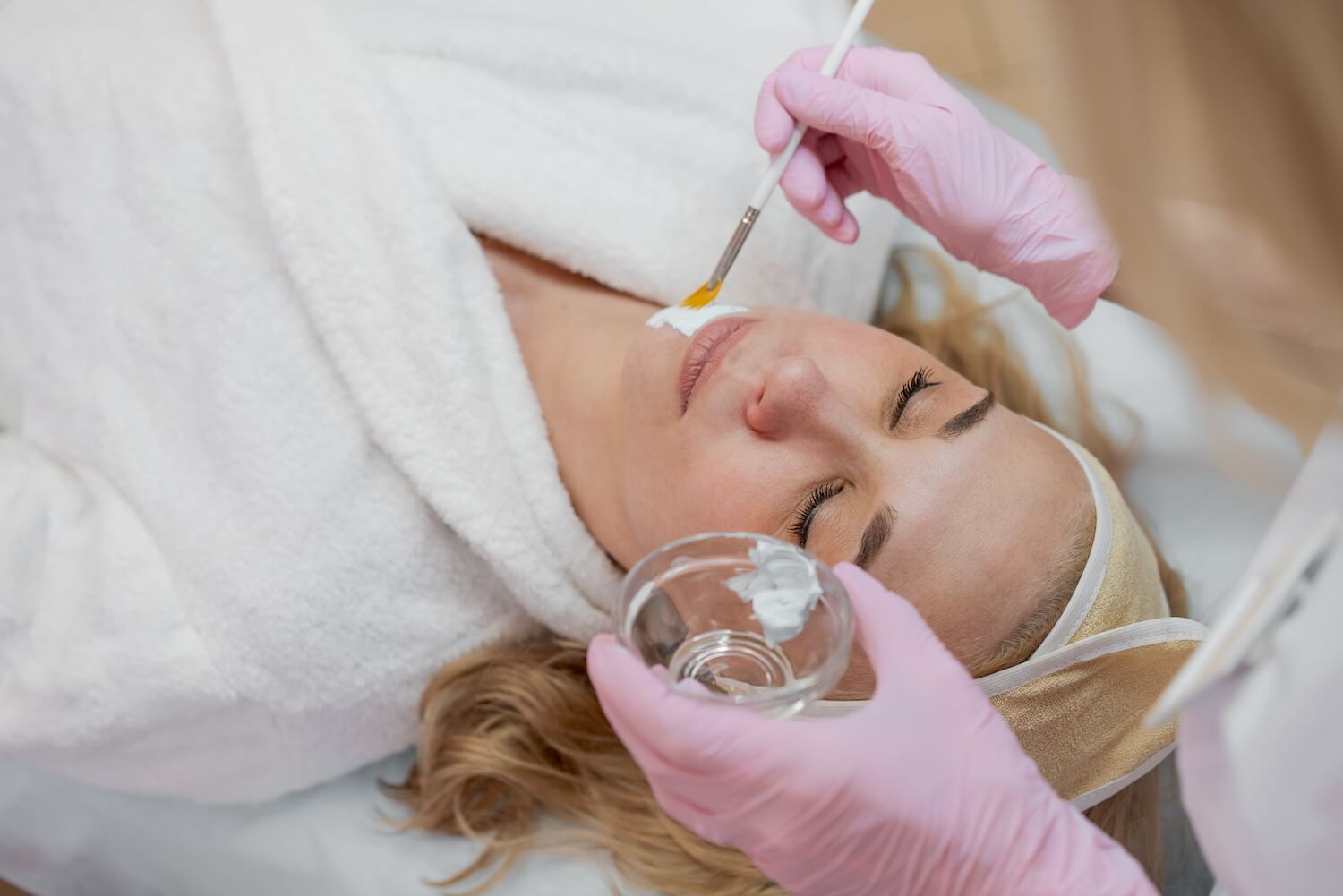When it comes to revealing brighter, smoother, and more youthful-looking skin, few treatments are as effective and time-tested as chemical peels. Despite the slightly clinical name, chemical peels are one of the most transformative, customizable, and science-backed skincare solutions available today. They don’t just exfoliate the skin—they help your complexion truly regenerate, from the inside out.
In this comprehensive guide, we’ll dive beneath the surface (literally and figuratively) to explore how chemical peels work, what types are available, the skin concerns they address, and why they remain one of the most sought-after treatments in both cosmetic dermatology and medical aesthetics.
What Is a Chemical Peel?
A chemical peel is a non-invasive cosmetic procedure that uses an acid-based solution to remove damaged, dead skin cells from the surface layers of your skin. By intentionally causing a controlled exfoliation or “wounding” of the skin, the peel stimulates the body’s natural healing processes. As the skin regenerates, it appears smoother, clearer, more even-toned, and more youthful.
Unlike abrasive physical exfoliants (like scrubs), chemical peels work more uniformly and precisely, allowing for a more targeted treatment with deeper and more consistent results. The idea isn’t to strip the skin harshly but to refresh it thoughtfully and safely under professional guidance.
The Science Behind Chemical Peels: How They Work
To truly understand how chemical peels work, we need to take a closer look at your skin’s structure. Your skin has multiple layers, with the outermost layer known as the epidermis. Beneath the epidermis is the dermis, which houses collagen, elastin, and other structures responsible for your skin’s tone, firmness, and hydration.
Chemical peels primarily target the epidermis but can also reach the dermis depending on their strength. When a chemical solution is applied to the skin, it temporarily disrupts the bonds between dead skin cells, allowing them to shed more efficiently. This process does several important things:
- Stimulates cellular turnover: Your skin regenerates more quickly, bringing fresh new cells to the surface.
- Encourages collagen production: Deeper peels trigger your skin’s natural repair response, leading to more collagen and elastin production over time.
- Improves absorption of skincare products: Once the barrier of dead skin cells is removed, your serums and moisturizers can penetrate more deeply and work more effectively.
- Refines texture and tone: As damaged or pigmented cells are sloughed away, your skin becomes more even, radiant, and refined.
This “out with the old, in with the new” principle is why peels are such a staple in aesthetic practices and skin care routines worldwide.
Types of Chemical Peels
Chemical peels aren’t one-size-fits-all. Depending on your skin concerns, goals, and downtime tolerance, there are different types to choose from:
1. Superficial (Light) Peels
Acids used: Glycolic acid, lactic acid, mandelic acid, salicylic acid (BHAs and AHAs)
These are the gentlest peels, ideal for people who want a refreshed glow without downtime. They target only the top layer of skin (the stratum corneum) and are often used for:
- Mild discoloration or dullness
- Clogged pores and blackheads
- Early signs of aging
- Uneven skin tone or rough texture
What to expect: Minimal tingling, mild redness or tightness for a few hours, and light flaking after a day or two. These peels are often dubbed “lunchtime peels” because you can get them and return to work the same day.
Best for: Maintenance, first-time users, or those with sensitive skin.
2. Medium Peels
Acids used: Trichloroacetic acid (TCA), Jessner’s solution, stronger glycolic acid concentrations
Medium peels penetrate deeper into the epidermis and sometimes the upper dermis. They’re designed for:
- Sun damage and pigmentation
- Fine lines and wrinkles
- Acne and post-acne scarring
- Melasma and uneven skin tone
What to expect: Redness, swelling, and moderate peeling over 5–7 days. Your skin may appear darker before the peeling begins, and sunscreen is critical during this recovery period.
Best for: Those with moderate skin concerns willing to undergo some downtime for more noticeable results.
3. Deep Peels
Acids used: Phenol, high-strength TCA
These are the most intensive peels, reaching the mid to lower dermis. They’re suitable for:
- Deep wrinkles and creases
- Severe sun damage
- Precancerous growths (like actinic keratoses)
What to expect: Significant downtime. Skin may be red, swollen, and crusted for up to two weeks, with full recovery taking several months. Because of the strength, these peels are typically administered only once and under medical supervision.
Best for: Severe skin concerns and patients seeking dramatic, long-term improvement.
What Skin Concerns Can Chemical Peels Treat?
One of the reasons chemical peels remain so popular is their ability to address a wide variety of skin conditions. They can be customized based on skin type, concern, and even season. Common concerns treated by peels include:
1. Acne and Acne Scarring
Peels unclog pores, reduce inflammation, kill acne-causing bacteria, and help fade post-acne marks. Salicylic acid peels are particularly effective for oily, acne-prone skin.
2. Hyperpigmentation and Melasma
By speeding up cell turnover and targeting melanin clusters, peels reduce the appearance of dark spots, sun damage, and pregnancy-related melasma.
3. Fine Lines and Wrinkles
Medium and deep peels stimulate collagen production, helping to soften lines around the eyes, mouth, and forehead.
4. Uneven Texture and Tone
Peels smooth out rough patches, minimize the appearance of large pores, and even out blotchy or ruddy skin tones.
5. Dull, Tired-Looking Skin
Even a light peel can deliver an instant glow by removing the buildup of dead cells that make the skin look sallow or lifeless.
The Chemical Peel Experience: What to Expect Before, During, and After
Pre-Treatment Prep
Your skincare professional may recommend prepping your skin with a specific regimen (like retinoids, glycolic acid, or pigment suppressors) for 1–3 weeks prior to the peel. This ensures even penetration and minimizes the risk of post-inflammatory hyperpigmentation.
Avoid sun exposure, waxing, and exfoliating in the days leading up to your peel. If you have a history of cold sores, antiviral medication may be prescribed to prevent flare-ups.
The Treatment Process
- Step 1: Cleansing: Your provider will start by thoroughly cleansing your skin to remove oils and debris.
- Step 2: Application: The chemical solution is applied in layers using gauze, a brush, or cotton-tipped applicators. You may feel a tingling or mild burning sensation, depending on the depth of the peel.
- Step 3: Neutralization: Some peels are self-neutralizing, while others are removed or neutralized with a separate solution.
- Step 4: Post-care application: A soothing balm or moisturizer is applied, and detailed aftercare instructions are given.
Aftercare and Recovery
- Superficial peels: Mild flaking, slight redness. Resume normal activities the same day.
- Medium peels: Skin may darken temporarily, peel in sheets, and require 5–7 days of downtime.
- Deep peels: Extensive recovery, including swelling, crusting, and redness. Requires careful monitoring.
Avoid sun exposure, retinoids, exfoliants, and active ingredients until your provider gives the green light.
Who Should Get a Chemical Peel?
Chemical peels are suitable for most skin types and tones, but they must be tailored carefully. Ideal candidates include:
- Those with fair to medium skin tones (though darker tones can safely receive peels with proper preparation)
- People experiencing acne, pigmentation, or fine lines
- Individuals with realistic expectations about outcomes and recovery
You may not be a good candidate if you have:
- Active skin infections, rashes, or open wounds
- A history of keloid scarring
- Very sensitive skin or skin conditions like eczema or rosacea (depending on severity)
Always consult a licensed skincare professional for a personalized evaluation.
How Often Should You Get a Chemical Peel?
The frequency depends on the type of peel, your skin goals, and how your skin responds:
- Light peels: Every 2 to 4 weeks for a series of 4–6 treatments, followed by monthly maintenance.
- Medium peels: Every 3 to 6 months.
- Deep peels: Typically done only once in a lifetime, though rare exceptions exist.
Your provider may recommend alternating with other treatments, such as facials or microneedling, for a comprehensive skin care regimen.
Combining Peels with Other Skincare Treatments
Chemical peels are often part of a larger skincare strategy. They can be combined with:
- Microneedling: To boost collagen and address scarring or texture concerns.
- Hydrafacials: For a deep clean and hydration before or after a light peel.
- Laser treatments: For pigmentation and vascular concerns.
- Injectables: Like Botox or fillers, which treat wrinkles from within while peels work on the surface.
An experienced provider will help you time and layer these treatments for the safest and most effective results.
Chemical Peel Myths: Separating Fact from Fiction
Let’s bust some common myths:
Myth 1: You’ll always peel like crazy. Not all peels cause visible peeling. Some work subtly beneath the surface without flaking at all.
Myth 2: They’re only for mature skin. Peels can benefit acne-prone teens, sun-damaged 30-somethings, and anyone seeking smoother, clearer skin.
Myth 3: Darker skin tones can’t get peels. False—with proper precautions and the right acids (like lactic or mandelic), peels are safe for deeper skin tones.
Myth 4: Peels thin your skin. In fact, the opposite is true: by stimulating collagen and elastin, peels help strengthen and thicken the dermis.
Final Thoughts: The Power of Renewal
Chemical peels go beyond the surface. They harness your skin’s natural regenerative power to improve clarity, smoothness, and radiance from within. Whether you’re dealing with stubborn breakouts, sun damage, early signs of aging, or just want to hit the refresh button, there’s likely a peel that’s perfect for your skin.
When guided by a skilled professional at KenshŌDerm, this simple-yet-sophisticated treatment can yield results that go far deeper than skin level. It’s not just about looking better—it’s about helping your skin function better, respond better, and glow more confidently.
Because true radiance isn’t just on the surface. It begins beneath it.

